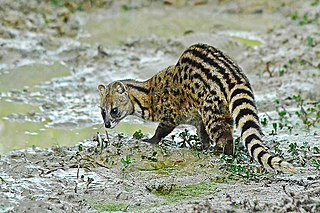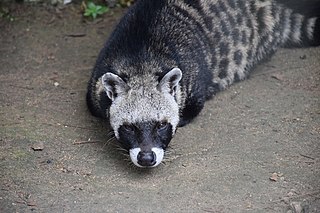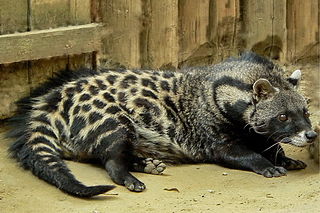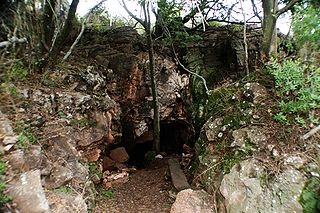
The Cradle of Humankind is a paleoanthropological site and is located about 50 km (31 mi) northwest of Johannesburg, South Africa, in the Gauteng province. Declared a World Heritage Site by UNESCO in 1999, the site currently occupies 47,000 hectares (180 sq mi) and contains a complex system of limestone caves. The registered name of the site in the list of World Heritage Sites is Fossil Hominid Sites of South Africa.

The African civet is a large viverrid native to sub-Saharan Africa, where it is considered common and widely distributed in woodlands and secondary forests. It is listed as Least Concern on the IUCN Red List since 2008. In some countries, it is threatened by hunting, and wild-caught individuals are kept for producing civetone for the perfume industry.

The small Indian civet is a civet native to South and Southeast Asia. It is listed as Least Concern on the IUCN Red List because of its widespread distribution, widespread habitat use and healthy populations living in agricultural and secondary landscapes of many range states.

Civettictis is a genus of viverrid that contains the extant African civet (Civettictis civetta) and a recently described extinct relative from the Plio-Pleistocene of South Africa known as Civettictis braini.
Kromdraai Conservancy is a protected conservation park located to the south-west of Gauteng province in north-east South Africa. It is in the Muldersdrift area not far from Krugersdorp.

A civet is a small, lean, mostly nocturnal mammal native to tropical Asia and Africa, especially the tropical forests. The term civet applies to over a dozen different species, mostly from the family Viverridae. Most of the species diversity is found in southeast Asia. The best-known species is the African civet, Civettictis civetta, which historically has been the main species from which a musky scent used in perfumery, also referred to as "civet", was obtained.
Charles Kimberlin Brain, also known as C. K. 'Bob' Brain, is a South African paleontologist who has studied and taught African cave taphonomy for more than fifty years.
Cooper's Cave is a series of fossil-bearing breccia filled cavities. The cave is located almost exactly between the well known South African hominid-bearing sites of Sterkfontein and Kromdraai and about 40 kilometres (25 mi) northwest of Johannesburg, South Africa and has been declared a South African National Heritage Site.
Gladysvale Cave is a fossil-bearing breccia filled cave located about 13 kilometres (8.1 mi) northeast of the well-known South African hominid-bearing sites of Sterkfontein and Swartkrans and about 45 kilometres (28 mi) north-northwest of Johannesburg, South Africa. It is situated within the Cradle of Humankind World Heritage Site and is itself a South African National Heritage Site.
Motsetsi Cave is a fossil-bearing breccia filled cavity located about 14 kilometres (8.7 mi) east of the well known South African hominid-bearing sites of Sterkfontein and Kromdraai and about 45 kilometres (28 mi) north-northwest of Johannesburg, South Africa. Motsetsi has been declared a South African National Heritage Site.

Plovers Lake Cave is a fossil-bearing breccia filled cavity in South Africa. The cave is located about 4 km Southeast of the well known South African hominid-bearing sites of Sterkfontein and Kromdraai and about 36 km Northwest of the City of Johannesburg, South Africa. Plovers Lake has been declared a South African National Heritage Site.
Kromdraai(means crooked turn in afrikaans) is a fossil-bearing breccia-filled cave located about 2 kilometres (1.2 mi) east of the well-known South African hominid-bearing site of Sterkfontein and about 45 kilometres (28 mi) northwest of Johannesburg, South Africa. It is situated within the Cradle of Humankind World Heritage Site and is itself a South African National Heritage Site.

The Viverrinae represent the largest subfamily within the Viverridae comprising five genera, which are subdivided into 22 species native to Africa and Southeast Asia. This subfamily was denominated and first described by John Edward Gray in 1864.
Gorgopithecus is an extinct genus of primate, in the old word monkey family Cercopithecidae, closely related to the baboons. There is only one known species, Gorgopithecus major. It has been found at sites from the Pliocene and Early Pleistocene Epoch in South Africa and Tanzania. It was first discovered at the Kromdraai A site in South Africa. It has since been found from Swartkrans, South Africa. Most recently, it has been recognized from the DKI site in Bed I of Olduvai Gorge, Tanzania, which has been dated to 1.8 million years old.

Viverra leakeyi, also known as Leakey's civet or the giant civet, is an extinct species of civet. Its fossils have been found in Africa, from Langebaanweg, Ethiopia, Tanzania, and the Omo Valley.
Kromdraai is a town in Sekhukhune District Municipality in the Limpopo province of South Africa.
Civet, also known as civet musk and civet oil, is the glandular secretion produced by both sexes of Viverridae species.
Suricata major is an extinct species of meerkat from the Early Pleistocene of Africa.
Minnaar's Cave, or simply Minnaar, is a palaeontological site located in the Cradle of Humankind World Heritage Site, Gauteng province, South Africa. Lost after its discovery in the 1930s, its location was rediscovered in 2009. It is known for its well-preserved jackal skulls, dating to the Plio-Pleistocene at least 2 million years ago.







